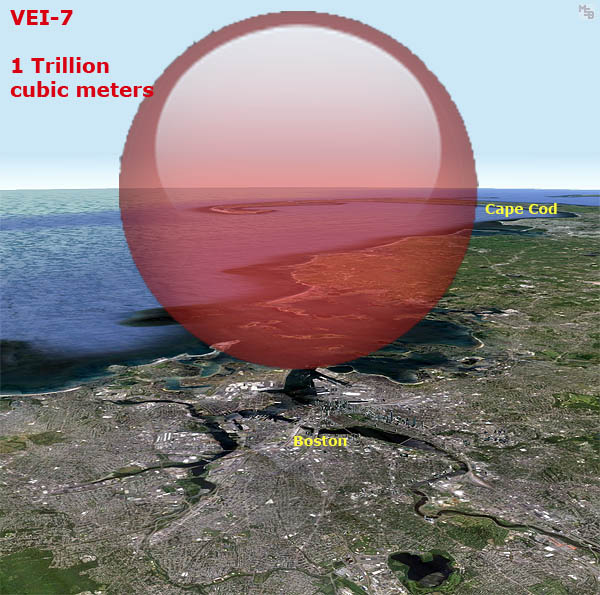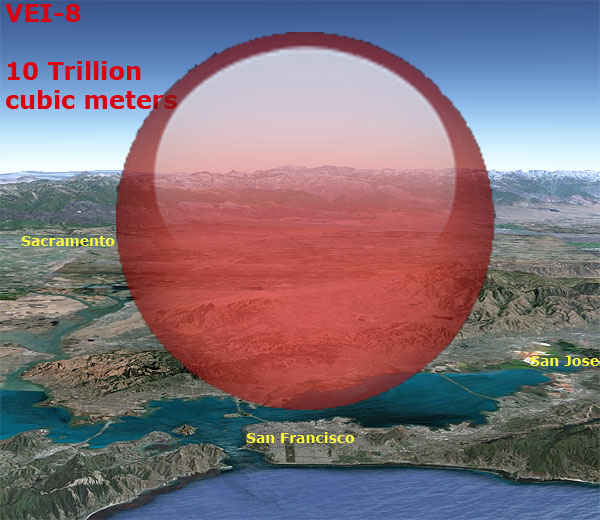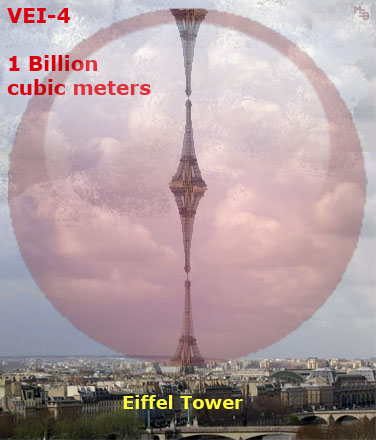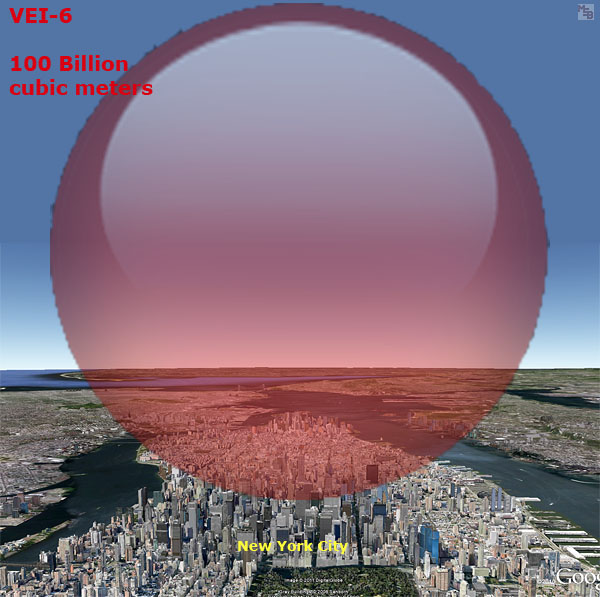How Big are Volcano Magma Chambers?

Remember that volcano that disrupted European air traffic for a few weeks during April, 2010? Have any idea how big its magma chamber would be if it were shaped like a sphere?
Volcanoes are rated on a scale called the Volcanic Explosivity Index, or VEI. The VEI scale ranges from 1 to 8, and each incremental whole number represents an explosivity of ten times the previous digit. In other words, the ash, rock, magma, ejecta of a VEI-4 volcano can be up to 10 times that of a VEI-3 volcano.
VEI-4 magma chamber
The Icelandic volcano, Eyjafjallajokull, having a rating of VEI-4 would mean that it has the potential to release between 100,000,000 (100 Million) and 1,000,000 (1 Billion) cubic meters of ash – ejecta – tephra.
To visualize the volume of how big that is, it would be the equivalent of having a magma chamber shaped as a sphere, the size of 4 Eiffel Towers stacked on top of each-other and spun into a spherical circle! That puts a new perspective on things…
VEI-5 magma chamber
Lets look at a few other examples to realize the magnitude of how large some of these magma chambers could be.
The next scale up, a VEI-5, has the potential to release 10 Billion cubic meters of ejecta. Mount St. Helens (USA) fits this category, as well as another Icelandic volcano named Katla (which has always erupted not long after Eyjafjallajokull).
To visualize an equivalent VEI-5 spherical magma chamber, imagine the tallest skyscraper building in the world, Burj Khalifa in Dubai, but not just one of them – but 3 of them stacked together and spun into a sphere!
VEI-6 magma chamber
Now we’re getting somewhere… a VEI-6 volcano, capable of releasing up to 100 Billion cubic meters of ejecta, could have a magma chamber with the equivalent volume of a sphere with a diameter of 5,760 meters or 18,898 feet! This is getting harder to visualize. How about 1.5 times the length of Central Park in in New York City revolved into a sphere, suspended over the city…
Famous VEI-6 volcanoes include Krakatoa (Indonesia) and Mount Pinatubo (Philippines).
VEI-7 magma chamber
Now we’re getting into very rare territory, that of a VEI-7 volcano, of which only 4 known eruptions exist in the Smithsonian Global Volcanism Program database. Only one VEI-7 eruption has been directly observed in recorded history, Mount Tambora (Indonesia) in 1815, which caused ‘the year without a summer’ in 1816. Lake Taupo caldera (New Zealand) erupted in this category during 180 AD.
To visualize a magma chamber capable of holding 1 Trillion cubic meters of magma – tephra – ejecta material, next time you are outside look up to see if you can spot a jet airliner, not just any flight in progress but one that is at the highest altitude you ever see – a tiny spec trailing across the sky. Now imagine that distance spun into a spherical circle. That’s how big it would be! (12,400 meters diameter, or 40,700 feet diameter)
VEI-8 magma chamber
Lastly, the VEI-8, a SuperVolcano capable of holding and releasing the equivalent spherical volume of 10 Trillion cubic meters, a sphere with a diameter of 26 kilometers (nearly 17 miles), is unimaginable.
Such an eruption would wreak annihilation and devastation never before witnessed. Global climate would be profoundly affected. Yellowstone (USA), Long Valley (USA), Lake Toba (Indonesia), and Taupo (New Zealand) fit into this category.
The best visualization I can come up with is while looking at the San Francisco Bay Area, as though from a very high altitude, the diameter of the sphere would be the same distance between the San Mateo bridge to the Oakland bay bridge, 16 miles. Locals will understand this magnitude.
It’s hard to imagine the massive size and volume, but the following image puts it into some perspective while visualizing the SF Bay Area with Sacramento, San Jose, and the Sierra’s in the background.

The formula for the magma chamber diameter (spherical chamber)
= 2 x radius, where radius = (total volume /((4/3)*(3.14)))^(1/3)
If you enjoyed this, or topics of preparedness, geophysical – current events – risks, consider our survival blog RSS feed, new posts by E-mail, or bookmark us at Modern Survival Blog



